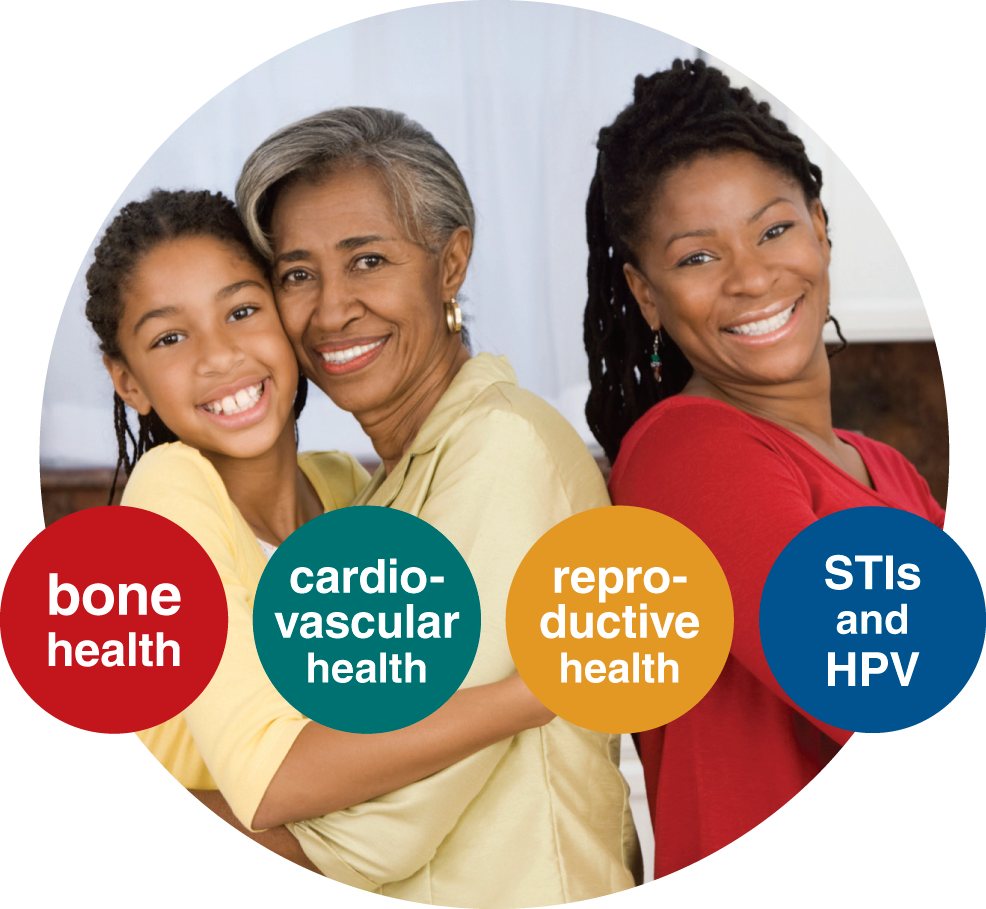Women’s health issues: 2014 update
Focus on Women's Health
When it comes to health care, men really could be from Mars and women from Venus. Women are more likely to seek medical care and use health care regularly than men are. They have unique and very different needs regarding their anatomical and hormonal makeup. Women also have unique psychological issues; they experience twice the rate of depression as men, regardless of race or ethnic background.
Over the past year, the pharmacotherapy landscape has undergone much change in the field of women’s health. Here are overviews of those changes and insights into the contributions pharmacists can make to the health of their women patients.
Bone health
Bone health is an area of much recent drug-related activity. Conjugated estrogens and bazedoxifene (Duavee—Pfizer) was approved by FDA last year for both moderate to severe vasomotor symptoms associated with menopause and prevention of postmenopausal osteoporosis. Odanacatib, developed by Merck & Co., is awaiting approval after its Phase III clinical trial was published in 2013.1 Romosozumab, which inhibits osteoblast activity, is currently in a Phase III clinical trial comparing its efficacy and safety with that of alendronate.
The National Osteoporosis Foundation published a new Clinician’s Guide to Prevention and Treatment of Osteoporosis, which included a recommendation on adequate intake of calcium (1000–1200 mg/d) and vitamin D (800–1000 IU/d) to reduce the risk of fracture.2 “Pharmacists can educate patients to not try to get vitamin D from the sun, which will increase the risk of skin cancer, but rather to get it from food sources or supplementation,” said Sally Rafie, PharmD, BCPS, Medication Safety Specialist, University of California at San Diego (UCSD) Health System, and Assistant Clinical Professor of Health Sciences, UCSD Skaggs School of Pharmacy and Pharmaceutical Sciences.
Bisphosphonates are also included in the recommendation, but with a limited duration of therapy of 3 to 5 years in low-risk patients due to emerging safety concerns, chiefly osteonecrosis of the jaw during prolonged therapy.
Cardiovascular outcomes
“A lot of older women are worried about getting breast cancer, but they are seven to eight times more likely to die of heart disease than breast cancer,” Rafie said. “Obesity is now a big problem, as one-third of women in the United States are obese, and it is only going to get worse.”
A recent study demonstrated that inactivity among a large cohort of Australian women was the highest attributable risk factor for heart disease compared with high body mass index, smoking, and high blood pressure.3 “Girls are getting obese now due to inactivity, which is a big concern,” added Rafie. “We have to approach this problem not just as a weight issue but as overall well-being. [Our clinic] has a team-model approach to taking care of our patients, which includes dietitian, pharmacist, and other providers [who] can send a message to the patient from multiple angles.”
“We are doing a good job at monitoring the use of hormonal replacement therapy for postmenopausal symptoms,” said Christina M. Madison, PharmD, BCACP, AAHIVP, Associate Professor of Pharmacy Practice at Roseman University of Health Sciences, and Clinical Pharmacy Faculty member at the Southern Nevada Health District in Las Vegas. “For some women, it does make a difference in their quality of life, so it might be warranted for short-term use at a low dose,” Rafie said. New data have emerged for using paroxetine for menopausal vasomotor symptoms. Paroxetine 7.5 mg safely reduces the frequency and severity of menopausal vasomotor symptoms persistently through 24 weeks of treatment, a study showed.4
Access to reproductive health care
Fifty percent of all pregnancies in the United States are unintended, according to Rafie. Sometimes it’s a question of access to service, according to Madison. In 2012, 15% of women lacked health insurance, “which should hopefully be addressed by the Affordable Care Act,” Rafie said. California has progressive medical care in helping women better manage their reproductive health; the state administers a program called Family Planning, Access, Care, and Treatment (Family PACT), which provides a comprehensive family planning service to 1.8 million low-income families, without any shared costs.5 “For every dollar we invest in [Family PACT], we save $9,” Rafie added.
Pharmacists’ roles in women’s health are also increasing in the nation’s most populous state. California’s 2013 law expanding pharmacists’ scope of practice includes furnishing self-administered hormonal contraceptives (HCs), independently ordering and administering routine vaccinations, and furnishing prescription medications for international travelers.
Adherence to HCs
“Adherence is an issue with oral contraception. … Women are missing two to three pills per cycle, but we don’t have a good system set up for women to ensure [their] continuous use,” said Rafie. This nonadherence may contribute to the unnecessary use of emergency contraceptives (ECs). “We also know that copper intrauterine devices (IUDs) are the most effective ECs and can potentially get the patient to see a physician for other health-related concerns since they have to be inserted by a health care provider,” Rafie said.
The removal of EC age restrictions and behind-the-counter checkpoints has given women the opportunity to prevent potentially unintended pregnancy; however, it also results in bypassing an important opportunity for pharmacists to educate patients about sexually transmitted infections (STIs) and future contraceptive methods, as well as to screen for any signs of mental health issues, sexual assaults, or domestic violence.
STIs and HPV immunization
“The incidence of STIs has plateaued, but we are still seeing an increase in HIV infections, disproportionately affecting women of color,” said Madison. “Part of the issue is a lack of early comprehensive sex education in schools about the transmission and prevention of STIs. A number of states are opting for ‘abstinence-only’ education in lieu of sex education.”
According to CDC’s Sexually Transmitted Disease Surveillance 2012, released in January 2014, the most prevalent STIs are chlamydia and gonorrhea, with peak incidence among 15- to 24-year-olds.6 Syphilis increased by 11% over a single year primarily because of increased rates in gay and bisexual men; women in relationships with bisexual men are at risk secondarily. Nearly 20 million new STIs occur each year, with 50% in young people aged 15 to 24 years. Of more than 110 million STIs currently in the United States, nearly 80 million cases are caused by human papillomavirus (HPV), making it the most common STI in the country.

“We offer HPV vaccination in our public health department’s Sexual Health Clinic to improve vaccination rates in at-risk men and women,” said Madison. “Since Tdap [diphtheria and tetanus toxoids, and acellular pertussis vaccine] is mandated in the state of Nevada to the sixth grade, HPV is also offered at the same visit to boys and girls, thereby increasing the vaccination rate.”
“We are finding that people do not complete the vaccination course,” Rafie added. “For unknown reasons, they do not get the second or third dose of HPV.” Because immunization records are not currently shared with community pharmacies in most cases, patients’ regular pharmacists cannot intervene and help increase the adherence rate for completion of HPV immunization. “If we can expand immunization scope of practice within the community pharmacy, this would definitely be helpful,” Rafie added.
Women older than 26 years sometimes inquire about receiving HPV vaccine. “A clinic can make a decision based on the FDA labeling, but if the patient is able to pay for the vaccination, she should get it,” Rafie said. “In theory, if she has not had any sexual encounters, she could also be able to get the vaccine, [because the age cutoff] is so arbitrary,” Madison added. “If women are able to complete the vaccine regimen within 6 months of turning 27 years old, we still vaccinate them even though they have already been sexually active because we don’t know to which strain they have been exposed. The vaccination can cover 70% of all cervical cancer. In development is a vaccine to cover the other 30% caused by strains beyond 6, 11, 16, and 18.” CDC publishes information for patients about HPV and how to discuss the vaccination with children.7
Pregnancy and lactation
Medication-related problems during pregnancy and fetal exposure to medications are of significant concern for all parties involved. According to CDC, about 90% of women take at least one medication during pregnancy, and 70% take at least one prescription medication. Over the past 30 years, use of prescription medications during the first trimester of pregnancy has increased by more than 60%. Information about teratogenic and lactation risks to the fetus is not always clear-cut with medication use. Many women do not realize they are pregnant until they are 6 to 8 weeks along, when the major fetal organs have begun or completed forming.
“One of the problems with the current pregnancy categories is that they do not take into account the dose and duration of the drug therapy received during the pregnancy,” Madison said. Clinicians have been waiting for a final rule on pregnancy and lactation labeling that FDA proposed in 2008, which would change the current system of letter designation to provide a more evidence-based summary of the risks and clinical considerations for clinicians. The proposed rule also addresses lactation risks in a similar manner.8 Pharmacists can use a free database called LactMed, provided by the National Institutes of Health both online and as a mobile application, to access peer-reviewed and referenced information on the effects of maternal medication use on infants.9
References
- http://press.endocrine.org/doi/abs/10.1210/jc.2012-2972
- http://nof.org/hcp/clinicians-guide
- Br J Sports Med. 2014 May 8 [Epub ahead of print]
- Menopause. 2013;20(10):1027–35
- www.familypact.org
- www.cdc.gov/std/stats12/
- www.cdc.gov/vaccines/VPD-VAC/hpv/default.htm#patient
- www.regulations.gov/#!documentDetail;D=FDA-2006-N-0515-0001
- http://toxnet.nlm.nih.gov/cgi-bin/sis/htmlgen?LACT

